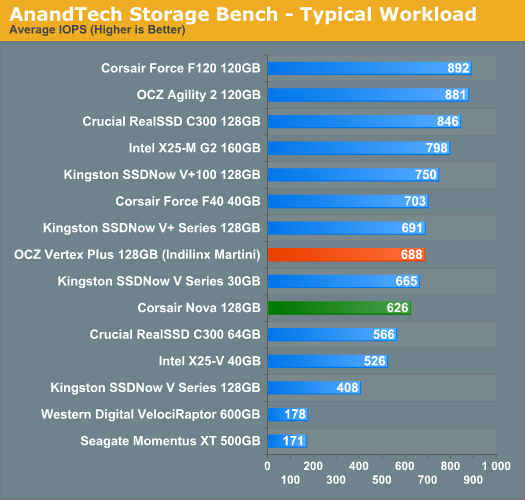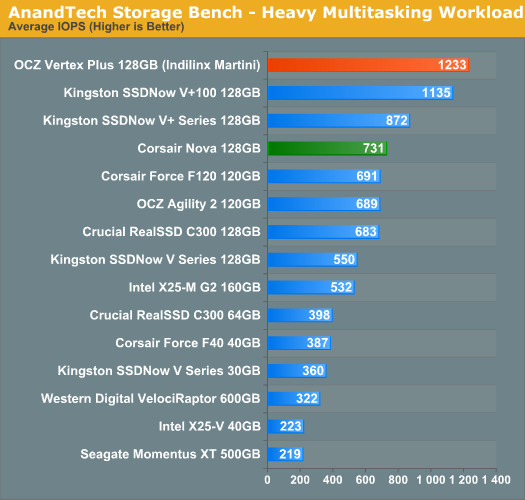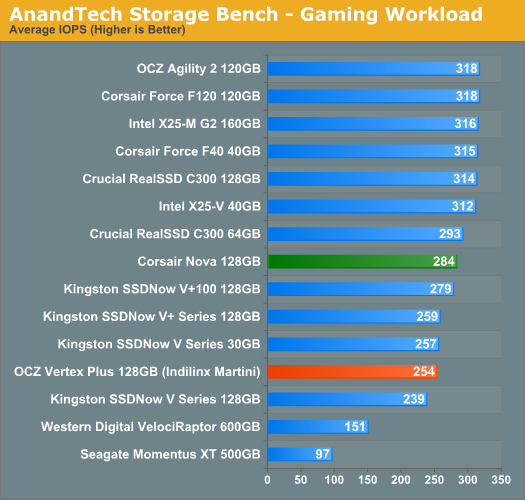OCZ Vertex Plus Preview: Introducing the Indilinx Martini
by Anand Lal Shimpi on November 16, 2010 9:31 AM EST- Posted in
- Storage
- SSDs
- OCZ
- Indilinx Martini
- Intrepid
AnandTech Storage Bench
To avoid any potential optimizations for industry standard benchmarks and to provide another example of real world performance we've assembled our own storage benchmarks that we've creatively named the AnandTech Storage Bench.
The first in our benchmark suite is a light/typical usage case. The Windows 7 system is loaded with Firefox, Office 2007 and Adobe Reader among other applications. With Firefox we browse web pages like Facebook, AnandTech, Digg and other sites. Outlook is also running and we use it to check emails, create and send a message with a PDF attachment. Adobe Reader is used to view some PDFs. Excel 2007 is used to create a spreadsheet, graphs and save the document. The same goes for Word 2007. We open and step through a presentation in PowerPoint 2007 received as an email attachment before saving it to the desktop. Finally we watch a bit of a Firefly episode in Windows Media Player 11.
There’s some level of multitasking going on here but it’s not unreasonable by any means. Generally the application tasks proceed linearly, with the exception of things like web browsing which may happen in between one of the other tasks.
The recording is played back on all of our drives here today. Remember that we’re isolating disk performance, all we’re doing is playing back every single disk access that happened in that ~5 minute period of usage. The light workload is composed of 37,501 reads and 20,268 writes. Over 30% of the IOs are 4KB, 11% are 16KB, 22% are 32KB and approximately 13% are 64KB in size. Less than 30% of the operations are absolutely sequential in nature. Average queue depth is 6.09 IOs.
The performance results are reported in average I/O Operations per Second (IOPS):

The Martini controller improves performance by around 10% compared to the Barefoot based Corsair Nova. It's enough to bring Indilinx's latest offering within striking distance of the new V+100 and smaller capacity SandForce drives, however the larger capacity SF drives are untouchable.
If there’s a light usage case there’s bound to be a heavy one. In this test we have Microsoft Security Essentials running in the background with real time virus scanning enabled. We also perform a quick scan in the middle of the test. Firefox, Outlook, Excel, Word and Powerpoint are all used the same as they were in the light test. We add Photoshop CS4 to the mix, opening a bunch of 12MP images, editing them, then saving them as highly compressed JPGs for web publishing. Windows 7’s picture viewer is used to view a bunch of pictures on the hard drive. We use 7-zip to create and extract .7z archives. Downloading is also prominently featured in our heavy test; we download large files from the Internet during portions of the benchmark, as well as use uTorrent to grab a couple of torrents. Some of the applications in use are installed during the benchmark, Windows updates are also installed. Towards the end of the test we launch World of Warcraft, play for a few minutes, then delete the folder. This test also takes into account all of the disk accesses that happen while the OS is booting.
The benchmark is 22 minutes long and it consists of 128,895 read operations and 72,411 write operations. Roughly 44% of all IOs were sequential. Approximately 30% of all accesses were 4KB in size, 12% were 16KB in size, 14% were 32KB and 20% were 64KB. Average queue depth was 3.59.

The Toshiba controllers have done very well in our heavy multitasking workload, as did the old Barefoot. Indilinx's Martini outdoes them both. The Vertex Plus is now our highest performing drive in our heavy multitasking workload. The SandForce drives fall short because much of this workload deals with incompressible data (JPEGs, .7z archives, etc...).
The gaming workload is made up of 75,206 read operations and only 4,592 write operations. Only 20% of the accesses are 4KB in size, nearly 40% are 64KB and 20% are 32KB. A whopping 69% of the IOs are sequential, meaning this is predominantly a sequential read benchmark. The average queue depth is 7.76 IOs.

Gaming performance took a slight hit compared to the old Barefoot. It's not enough to be a huge deal, especially considering the other improvements.










61 Comments
View All Comments
jordanclock - Tuesday, November 16, 2010 - link
Garbage collection is file-system agnostic. It happens on a level between hardware and the file-system. It will work for any and all file-systems.Jaybus - Tuesday, November 16, 2010 - link
Unlike a spinning disk, there is no penalty for where blocks are physically placed. The controller therefore maps the address of the requested block to the real physical location of the block. This mapping is internal to the drive controller and at a lower level (the block level) than the file system. When a SATA request comes in to write a block that has previously been written to and already contains data, the controller would normally have to erase the block before writing the new data. What garbage collection does is change the mapping so that the write is made to a block that is already erased, while the old block is mapped to a list of blocks that now contain stale (ie. garbage) data. The idea is that this speeds up the writes, since the erase is delayed and performed later when disk activity is idle.This doesn't require a TRIM command, since it is all handled internally by the drive controller. It is at the block level, so file system used doesn't matter.
melgross - Tuesday, November 16, 2010 - link
So, and I asked this before, in another thread, is there an advantage to trim. If so, what else is it doing that would make that true? I received no answer there.akedia - Tuesday, November 16, 2010 - link
TRIM is a command from the operating system to the drive to clean up its dirty sectors and ready them for new data. Background garbage collection is the hard drives quietly doing the same thing by themselves when they're idle. Either way it's a process that must be undergone to keep the SSD operating well.The benefit of TRIM is that the operating system is much better at knowing when it's about to access the drive than the drive is at guessing when it's going to be accessed by the operating system, so TRIM can fulfill the function more efficiently and diligently. The big drawback to TRIM is that not all operating systems have it. Thus the Crucial RealSSD C300, which can receive TRIM commands but cannot do background garbage collection, is arguably the best available SSD on Windows 7, which has TRIM, but would have its performance degrade very badly over time on OS X, which does not, while the SandForce SSDs like the OCZ Vertex 2 performs about equally on either system, their own garbage collection taking care of things.
In short, yes, there is a benefit to TRIM in keeping SSDs functioning optimally over time better than idle garbage collection most of the time, IF you have an operating system AND an SSD that utilize the command.
cdillon - Tuesday, November 16, 2010 - link
Garbage collection doesn't have ANY knowledge of file-systems like some people seem to think. That would be entirely too dangerous for your data. Block devices have absolutely no business erasing your data without the OS asking it to.Garbage Collection and TRIM are orthogonal. When new data is written to the SSD, it is written to the pre-erased blocks that exist in the spare block pool. The LBA for that data will now point to the new flash block. Since the contents of the logical blocks are now stored in different physical flash blocks, the old flash blocks now contain orphaned "garbage" data and can be erased and returned to the spare pool. The purpose of Garbage Collection is to erase these previously used blocks and put them back into the spare pool.
This allows for fast writes and some wear-leveling. If you over-run the spare pool with your writes then you'll see the writes slow down until garbage collection and/or TRIM has recovered at least some of the spare block pool.
The advantage of TRIM is that it gives the SSD information about ADDITIONAL blocks that can be erased and put into the spare pool above and beyond the fixed spare pool. The smaller the fixed spare pool size is on an SSD, the more TRIM will benefit.
melgross - Wednesday, November 17, 2010 - link
Well, this is what I thought from what I've read.But, it also seems to me that you can get performance at least as good as trim with controllers that are aggressive, as aggressive as the trim itself may be. We can see from the new Toshiba controller that performance can remain at about 100% if it's aggressive. Yes, that may lead to reduced life, but that's got to be tested.
One advantage I see for garbage collection by the drive itself is that it's matched to the drivef and the extra flash should help determine how aggressive it can get. But trim is independent of the drive, as so treats each drive the same. That could result in poorer performance, and possible shorter lifetime.
I still don't see where any advantage to trim exists.
dbt - Tuesday, November 16, 2010 - link
And.... more importantly, another good article - thankyou !cactusdog - Tuesday, November 16, 2010 - link
I have a vertex2 that im very happy with it but cant OCZ come up with a different name instead of having different controllers under the same model of "vertex" with very different performance levels. Its a good way to confuse consumers.Shadowmaster625 - Tuesday, November 16, 2010 - link
I guess this is why you can buy one of the original vertexes (vertices?) for $40 after rebate.mschira - Tuesday, November 16, 2010 - link
All these 2.5" SSD's are fine for desctops and for replacement in existing Laptops.But where is the move towards 1.8" models or better the super small form factor the MacBook air uses? (btw. does anybody know what sort of SSD the Sony Z-Series uses?)
2.5" drives are getting a limitation for small thin notebooks. Time to get rid of them!!!!
M.